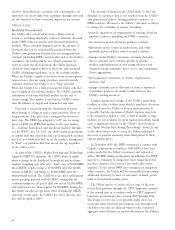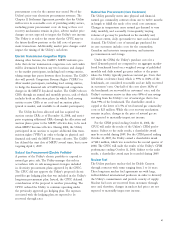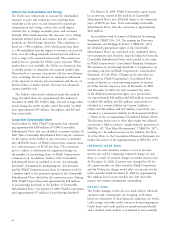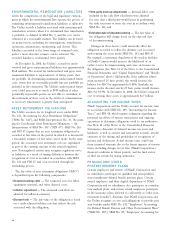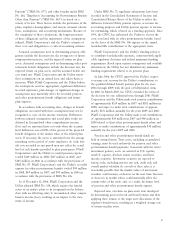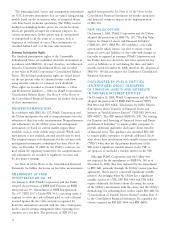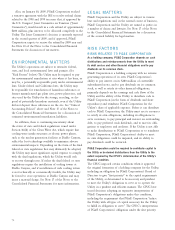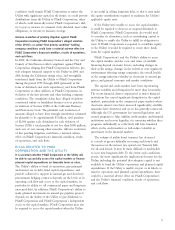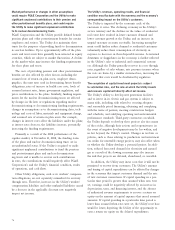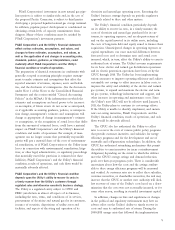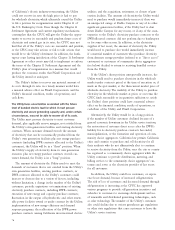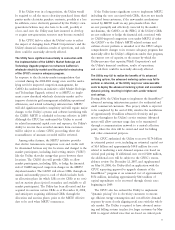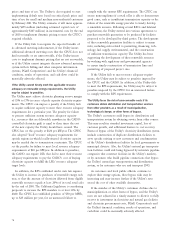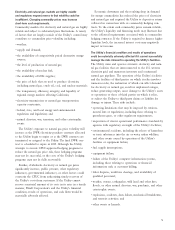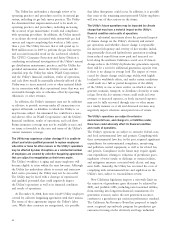PG&E 2008 Annual Report Download - page 74
Download and view the complete annual report
Please find page 74 of the 2008 PG&E annual report below. You can navigate through the pages in the report by either clicking on the pages listed below, or by using the keyword search tool below to find specific information within the annual report.72
LEGAL MATTERS
PG&E Corporation and the Utility are subject to various
laws and regulations and, in the normal course of business,
PG&E Corporation and the Utility are named as parties in
a number of claims and lawsuits. See Note 17 of the Notes
to the Consolidated Financial Statements for a discussion
of the accrued liability for legal matters.
RISK FACTORS
RISKS RELATED TO PG&E CORPORATION
As a holding company, PG&E Corporation depends on cash
distributions and reimbursements from the Utility to meet
its debt service and other fi nancial obligations and to pay
dividends on its common stock.
PG&E Corporation is a holding company with no revenue
generating operations of its own. PG&E Corporation’s
ability to pay interest on its $280 million of convertible
subordinated notes, and to pay dividends on its common
stock, as well as satisfy its other fi nancial obligations,
primarily depends on the earnings and cash fl ows of the
Utility and the ability of the Utility to distribute cash to
PG&E Corporation (in the form of dividends and share
repurchases) and reimburse PG&E Corporation for the
Utility’s share of applicable expenses. Before it can distribute
cash to PG&E Corporation, the Utility must use its resources
to satisfy its own obligations, including its obligations to
serve customers, to pay principal and interest on outstanding
debt, to pay preferred stock dividends, and to meet its obli-
gations to employees and creditors. If the Utility is not able
to make distributions to PG&E Corporation or to reimburse
PG&E Corporation, PG&E Corporation’s ability to meet
its own obligations could be impaired, and its ability to
pay dividends could be restricted.
PG&E Corporation could be required to contribute capital to
the Utility or be denied distributions from the Utility to the
extent required by the CPUC’s determination of the Utility’s
fi nancial condition.
The CPUC imposed certain conditions when it approved
the original formation of a holding company for the Utility,
including an obligation by PG&E Corporation’s Board of
Directors to give “fi rst priority” to the capital requirements
of the Utility, as determined to be necessary and prudent
to meet the Utility’s obligation to serve or to operate the
Utility in a prudent and effi cient manner. The CPUC later
issued decisions adopting an expansive interpretation of
PG&E Corporation’s obligations under this condition,
including the requirement that PG&E Corporation “infuse
the Utility with all types of capital necessary for the Utility
to fulfi ll its obligation to serve.” The CPUC’s interpretation
of PG&E Corporation’s obligation under the fi rst priority
Also, on January 30, 2009, PG&E Corporation reached
a tentative agreement with the IRS to resolve refund claims
related to the 1998 and 1999 tax years that, if approved by
the U.S. Congress’ Joint Committee on Taxation (“Joint
Committee”), would result in a cash refund of approximately
$200 million, plus interest, to be allocated completely to the
Utility. The Joint Committee’s decision is currently expected
in the second quarter of 2009, and if approved, PG&E
Corporation expects to receive the refund by 2009 year end.
See Note 10 of the Notes to the Consolidated Financial
Statements for discussion of tax matters.
ENVIRONMENTAL MATTERS
The Utility’s operations are subject to extensive federal,
state, and local environmental laws and permits. (See
“Risk Factors” below.) The Utility may be required to pay
for environmental remediation at sites where it has been, or
may be, a potentially responsible party under environmental
laws. Under federal and California laws, the Utility may
be responsible for remediation of hazardous substances at
former manufactured gas plant sites, power plant sites, and
sites used by the Utility for the storage, recycling, or dis-
posal of potentially hazardous materials, even if the Utility
did not deposit those substances on the site. See “Critical
Accounting Policies” above and Note 17 of the Notes to
the Consolidated Financial Statements for a discussion of
estimated environmental remediation liabilities.
In addition, there is continuing uncertainty about
the status of state and federal regulations issued under
Section 316(b) of the Clean Water Act, which require that
cooling water intake structures at electric power plants,
such as the nuclear generation facilities at Diablo Canyon,
refl ect the best technology available to minimize adverse
environmental impacts. Depending on the form of the fi nal
federal or state regulations that may ultimately be adopted,
the Utility may incur signifi cant capital expense to comply
with the fi nal regulations, which the Utility would seek
to recover through rates. If either the fi nal federal or state
regulations require the installation of cooling towers at
Diablo Canyon, and if installation of such cooling towers
is not technically or economically feasible, the Utility may
be forced to cease operations at Diablo Canyon and may
incur a material charge. See Note 17 of the Notes to the
Consolidated Financial Statements for more information.


